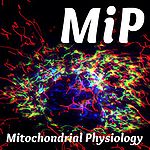Persson 2013 Abstract MiP2013
| Persson P, Palm F, Friederich-Persson M (2013) The effects of Angiotensin II on mitochondrial respiration: A role of normoglycemia versus hyperglycemia. Mitochondr Physiol Network 18.08. |
Link:
MiP2013, Book of Abstracts Open Access
Persson P, Palm F, Friederich-Persson M (2013)
Event: MiPNet18.08_MiP2013
Exaggerated activation of the renin angiotensin aldosterone system (RAAS) is a key feature in diseases such as hypertension, diabetes and chronic kidney damage. Angiotensin II (Ang II) can activate type 1 receptors (AT1R), resulting in increased blood pressure and formation of reactive oxygen species via activation of the NADPH oxidase, or type 2 (AT2R) receptors, normally counter-acting AT1R-activation. Recently, an intracellular RAAS was demonstrated with AT1R and AT2R expressed in nucleus and mitochondria [1]. AT1R activation in nucleus increases production of inflammatory cytokines, but the function of mitochondrial AT1R is unknown. AT2R in both nucleus and mitochondria is coupled to increased nitric oxide (NO) production and subsequently decreased mitochondrial respiration. Interestingly, diabetes is associated with both mitochondrial dysfunction [2] and increased intracellular Ang II concentration [3]. Therefore, the present study investigated the role of Ang II in kidney cortex mitochondria isolated from control and streptozotocin-induced diabetic rats.
Mitochondrial respiration was recorded after addition of Ang II (1 µM), candesartan (AT1R antagonist, 100 nM), Ang II + candesartan, Ang II + PD-123319 (AT2R antagonist; 3 µM) or in combination. Mitochondria isolated from diabetic animals were also incubated with L-NAME (nitric oxide synthase inhibitor).
Ang II decreased oxygen consumption in mitochondria from both control (16.9±1.0%) and diabetic animals (-15.0±0.0%). AT1R inhibition did not affect the response to Ang II, whereas AT2R inhibition abolished the response in mitochondria from control animals. However, AT2R inhibition resulted in increased oxygen consumption in mitochondria from diabetic animals (+10.4±1.0%), but combined AT1R and AT2R inhibition did not exert any effect in either of the groups. Furthermore, mitochondria from diabetics displayed increased oxygen consumption in response to Ang II in the presence of nitric oxide synthase inhibition (+10.9±2.4%).
In conclusion, Ang II regulates mitochondrial respiration via AT2R-mediated NO release in both control and diabetic animals. AT1R does not regulate mitochondrial function in control animals, but can regulate mitochondrial function in diabetic animals in the absence of AT2R. Taken together, these results demonstrate a role of Ang II in regulation of kidney mitochondria function.
• O2k-Network Lab: SE Uppsala Liss P
Labels: MiParea: Respiration, mt-Medicine Pathology: Diabetes Stress:Oxidative stress;RONS Organism: Rat Tissue;cell: Kidney Preparation: Isolated mitochondria
HRR: Oxygraph-2k
MiP2013
Affiliations and author contributions
1 - Dept of Medical Cell Biology, Uppsala University, Sweden;
2 - Dept of Medical and Health Sciences, Linköping University, Sweden;
3 - Center for Medical Image Science and Visualization, Linköping University, Sweden.
Email: [email protected]
References
- Abadir PM, Foster DB, Crow M, Cooke CA, Rucker JJ, Jain A, Smith BJ, Burks TN, Cohn RD, Fedarko NS, Carey RM, O'Rourke B, Walston JD (2011) Identification and characterization of a functional mitochondrial angiotensin system. Proc Natl Acad Sci U S A 108: 14849-14854.
- Persson MF, Franzen S, Catrina SB, Dallner G, Hansell P, Brismar K, Palm F (2012) Coenzyme QA10 prevents gdp-sensitive mitochondrial uncoupling, glomerular hyperfiltration and proteinuria in kidneys from db/db mice as a model of type 2 diabetes. Diabetologia 55: 1535-1543.
- Singh VP, Le B, Khode R, Baker KM, Kumar R (2008) Intracellular angiotensin ii production in diabetic rats is correlated with cardiomyocyte apoptosis, oxidative stress, and cardiac fibrosis. Diabetes 57: 3297-3306.
